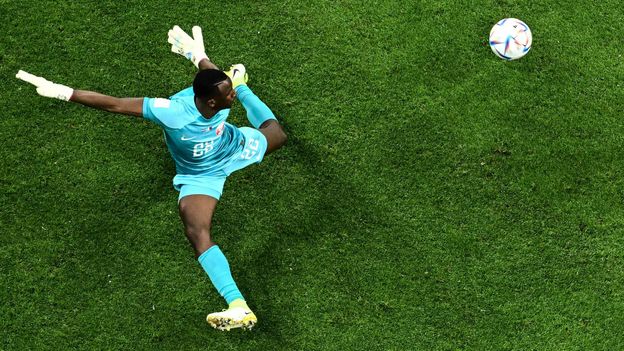
What would a green World Cup look like?
[ad_1]
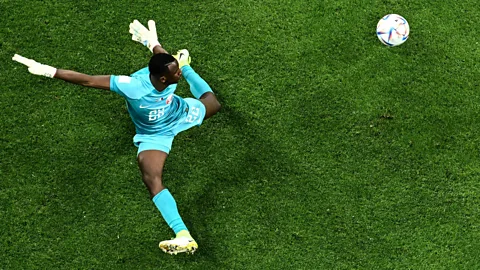 Jewel Samad/Getty Images
Jewel Samad/Getty ImagesWhat would it take to really make the World Cup, and other sports mega-events, a genuine part of a low-carbon world?
Humanity is deep in the throes of the World Cup. Billions of people are expected to tune in to at least one match of the 2022 Qatar tournament – a significant proportion of the global population.
The scale of the challenge is undeniably vast. Some might question whether the World Cup as we know it now – with teams, fans and officials flying long distances and massive infrastructure development – can ever become sustainable. Would the basic model of the event need to change to become greener, and if so, what might that look like?
“It is hard to think of a different sector that attracts the attention of literally billions of human beings across the globe,” says Suki Hoagland, a lecturer at the Stanford Doerr School of Sustainability in California. “It will be a bellwether of how the rest of society is responding.”
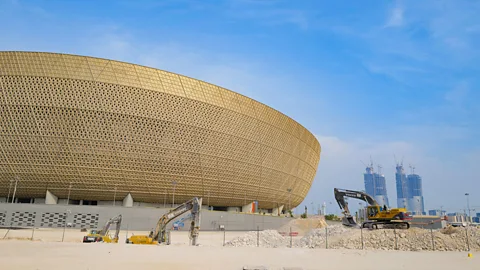 Matthew Ashton/Getty Images
Matthew Ashton/Getty ImagesIt’s a huge amount, albeit still a small fraction of global emissions. But since emissions across the planet as a whole need to be halved by 2030, Fifa should also, at the very least, halve its emissions by 2030, argues Khaled Diab, communications director at Carbon Market Watch and editor of its report on Fifa’s carbon neutrality claim. Considering that sport is “not a life-or-death sort of activity”, perhaps it should be even more ambitious than this, he adds.
What is CO2e?
CO2 equivalent, or CO2e, is the metric used to quantify the emissions from various greenhouse gases on the basis of their capacity to warm the atmosphere – their global warming potential.
There are two major areas of environmental impact from the World Cup. Number one: transport. Flying by air is incredibly carbon-intensive, making fan flights the largest source of emissions from every major international sporting event, says Madeleine Orr, a lecturer at Loughborough University London and founder of the Sport Ecology group of academics. And then there is the gigantic energy and material footprint of building new stadiums, along with the transport networks and hotels to accommodate hundreds of thousands of fans.
These two areas overlap because they are largely around the movement and accommodation of fans, not the footballers and their entourage.
Much can be done to reduce the environmental impact of new buildings, of course. One obvious starting point is sourcing low-carbon energy to power them, such as by building solar projects nearby. “Your energy consumption should all come from renewable energy,” says Dale Vince, owner of Forest Green Rovers football club in the UK and founder of Ecotricity, a renewable electricity company. “But at the same time, you should be super-efficient with that, using low consumption devices like LEDs for floodlights, for example, and energy efficient appliances.”
To lower emissions, construction could move away from conventional concrete-based structures, says Vince. Carefully considering the connections between key buildings in the World Cup could also help lower emissions, with electric buses, electric cars, personal mobility scooters or simply walking prioritised.
Vince envisions a green World Cup based in stadiums built entirely out of wood, all situated close together “so that if you fly in, you’re in the World Cup village, and you can watch every game you want to without travelling other than by electric bus”.
Another way to reduce the huge footprint of building many new stadiums would be to avoid building them in the first place. One option here could be reducing the number of teams playing in the final tournament, says Russell Seymour, executive chair at the British Association for Sustainable Sport. Having hubs where the top teams from each region come together for a smaller final tournament would reduce impacts, he notes.
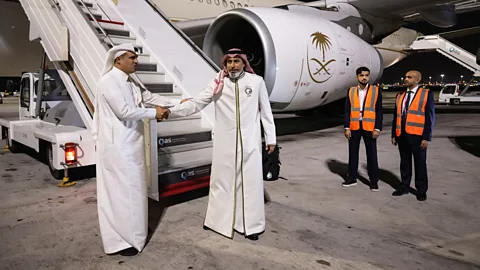 Oliver Hardt/Fifa/Getty Images
Oliver Hardt/Fifa/Getty ImagesClaire Poole, a sports event consultant and founder of the Sport Positive summit, says matches could also take place in locations with existing stadiums and energy efficient infrastructure, as well as being well connected to transport routes.
Fifa could even consider a permanent venue for the World Cup, says Diab. “The lowest carbon stadium or the most environmentally friendly stadium is the stadium that is not built.” This is especially the case where stadiums are being built in areas that may not be able to find a use for stadiums after the World Cup is over. In Qatar, for example, he says, it’s “open to question” how so many world class stadiums in such a small geographical area will be used after the tournament. “We’ve seen in previous tournaments of these becoming stranded assets, just left to crumble or being underutilised after the World Cup.”
Orr’s vision of smaller, greener World Cups would reduce the focus on them as tourist events, eliminating the need for 60,000-seater stadiums, and focus more on their nature as international competitions that feature the best athletes around the world.
Downsizing attendance at the World Cup would help to do away with the expectation for host countries to provide huge stadiums and several hundred thousand hotel rooms, says Orr. It would also open the door to a long list of countries that are currently nowhere near being able to host something of the magnitude of the World Cup, but who could then use their existing stadiums, making it “a lot easier to clean up that [environmental] footprint credibly”, Orr says.
Smaller stadiums would also open the door for other sustainability measures, says Orr, like the use of reusable cups – much more feasible for a stadium of 20,000 people than 60,000 people. “Just by reducing the scope of the event, we start to unlock solutions,” she says.
These events could see greater media presence to deliver as good an experience as possible to those watching around the world. Designated fan zones already spring up unofficially around the world, notes Orr, but these could be made more official.
“We’re very close to having really strong hologram technology and good projector technology that could show you in live time what the field looks like in [for example] China, but in Wembley,” says Orr. “All the London or England-based fans would have the option to go to Wembley to watch that game in live time with their fellow fans… with the experience of that elevated, high-stress game, which is really important. There’s room for all of this to work. We just have to divorce it from being the biggest centralised party in the world to become the biggest decentralised party in the world.”
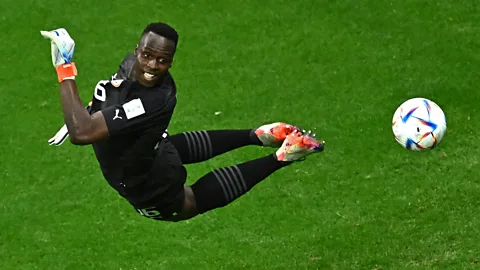 Jewel Samad/Getty Images
Jewel Samad/Getty ImagesEven before this technology exists, regional fan hubs could be established at a larger scale so people can enjoy the excitement without having to travel, notes Poole. It could be a hard sell, however, for many fans who dream of travelling to the World Cup at least once in their lives. And while the pandemic showed that football played behind closed doors can work, “it’s not the same – especially on a world stage, we need the fans there”, says Poole.
A plausible green solution could therefore be a mix of the two: a downsized event with most tickets going to fans from the region who could travel there without using planes, and quotas on international tourists attending.
Another possibility could be a more decentralised World Cup that sees home and away teams playing at the nearest convenient location between the two teams, says Diab, minimising the amount of travel for the teams and their fans. This could also be a way to democratise football, allowing people to go to one game of the World Cup in their local area, he adds: after all, currently only those who can afford the price of tickets, travel and accommodation actually get to see the World Cup in person anyway. “Maybe if you have the distributed system you give an opportunity for more people, actually, not fewer people to attend matches,” he says.
However, there is also the social value of World Cups for host nations to consider. World Cups bring huge prestige for the host nation, but can also bring other lasting social impacts, says Rutendo Musikavanhu, a senior lecturer in architecture and cities at the University of Westminster in London. “These events do present an opportunity for change [and to] engage in political cultural debate,” she says. They can bring diverse groups of people together that were previously segregated or marginalised, she says. “Sports do bring people together, there’s a unique sense of happiness that is brought about, there’s a level of escapism from our day to day.”
In her research looking at the legacy of the 2010 World Cup in South Africa, for example, one respondent told her it was their first time ever to sit next to somebody of a different skin colour or ethnicity. The participant, who was black, also recounted feeling comfortable for the first time about speaking to a white South African in a bar, she says. “Football generates a very unique sense of togetherness, and a unique level of excitement is brought about by such a platform [as hosting the World Cup]. The World Cup was a vehicle for this [encounter], it allowed people to see beyond themselves.”
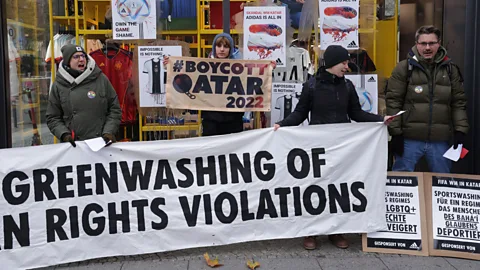 Sean Gallup/Getty Images
Sean Gallup/Getty ImagesOrr also sees a green World Cup as being hosted by one main country – allowing them to get the benefit of the publicity and tourism brought by the event. “If we have such a decentralised event that all the players and all the teams are in different places, then you’ve got teams flying all over the world back and forth, which doesn’t make any sense.”
In the longer term, the world could start to see more widespread decarbonisation of aviation through alternative renewable fuels (or even electric planes over short distances), opening up more opportunities for low-carbon travel. Until the time when these kinds of options exist and are affordable, however, the question of offsets is likely to remain.
Offsetting means paying for an external project to reduce or sometimes absorb the emissions a country, organisation or person is emitting. But some argue in many cases they simply don’t work as intended, as, for example, it can be hard to ensure a forest stays standing or be sure a renewable power plant would not have been built even without the investment. Environmentalists are therefore concerned offsets can act as a “dangerous distraction” from what’s really needed – cutting emissions.
Diab argues the World Cup shouldn’t be using offsets at all to claim carbon neutrality – as it gives the misleading impression it is not leading to overall damage to the climate, he says. The event could still promote its contribution to climate finance, he says, but not claim this as negating its own emissions.
But if any carbon offsets are being used to claim “carbon neutrality”, the organisers could ensure they are of the highest quality – reliable, long-lasting reductions in emissions that would not have happened without the investment.
An important part of offsetting any World Cup is also taking action to better understand the current footprint today, and setting credible goals for reducing this, says Roger McClendon, executive director of the Green Sports Alliance. “You have to be careful about greenwashing and not overstating what you’re doing,” he says. This would mean being transparent about progress, he says, even if it means, for example, admitting that only 30% of emissions are credibly mitigated or offset to begin with. “Then we work our way from there to 40%, 50%, till we get to 100% net zero [in future events].”
Back in 2018, Vince’s football team, Forest Green Rovers, became the first UN-certified carbon neutral sports club in the world. “It is okay to use carbon offsets, but they can’t be used ahead of everything else,” says Vince. “You’ve got to do the measurement properly and diligently, you’ve got to reduce as far as you possibly can, and then, and only then, use offsets to deal with the residual [emissions]. This is a job that never stops, and Fifa should be doing this with every subsequent World Cup, it should get better and better.”
Important as it is for the World Cup to reduce its carbon footprint, its huge reach means it could have far wider and longer-lasting impacts than the month-long event itself.
Sport occupies a hugely important and, in many ways, unique place in global culture. “The potential for the sports industry to increase human awareness and understanding of the challenges we face and the next steps of how to engage, act and adapt behaviours is a ‘game changer’,” says Hoagland.
In fact, if sport in general embraced a low-carbon approach it could “influence millions of people to make, and accept, changes in their life”, says Seymour.
 Alamy
Alamy“Food is just so easy and obvious: don’t have animals in the food at the World Cup,” says Vince, whose own football club went vegan in 2017. One substantial change many people can make personally is to reduce the quantity of animal products they consume, and our own dietary choices can influence the choices of those around us. “And it’s the same for any sporting event. It’s the showcase, the symbolism, the example that’s being set.”
But a green World Cup would have to go much further than changes to food alone: much greater consideration would be put into what is advertised on everything from footballers shirts to banners around the stadium and TV ads. For one thing, there would be a marked absence of products or brands associated with high carbon lifestyles, such as airlines and SUVs, says Seymour.
There is a huge dissonance between hearing a sports event is “carbon neutral” then attending and seeing airlines and fossil fuel companies advertised on jerseys, agrees Orr. “That is sending a very different message to me about their values and where they’re going and what they are trying to achieve, by who they’re aligning themselves with, and what they’re trying to sell me.” Seeing vegan protein, electric car and renewable energy companies advertising would create a very different picture, she says. Sport has done this before, she notes – cigarettes used to be widely advertised in sports including football, for example, but are now no longer promoted in many countries.
In fact it’s hard to overestimate the impact of a World Cup that visibly embraced and promoted genuine and credible climate action. But individual sports celebrities also have a huge impact on wider culture. It’s an engagement that has not always been welcomed by sports organisations, however – many were angered this year when Fifa sent a request to World Cup teams to “focus on the football” rather than discussing human rights issues in Qatar.
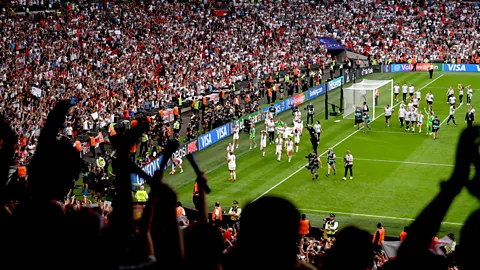 Michael Regan/Getty Images
Michael Regan/Getty ImagesFootball and other sports have a long history of social activism and supporting racial justice and civil rights, often with huge influence. “Footballers have a huge status as role models, and football is something that inspires hundreds of millions of people around the world,” says Seymour. “So what happens in the realm of football has knock on effects in wider society – it sets the tone for a lot of other things.”
A truly green World Cup would therefore also mean individual footballers and other sports leaders both speaking about climate action and implementing it in their own lives – such as by avoiding private jet use.
Some people question whether it is fair to ask athletes to take on the climate challenge when they are already tasked with raising the profile of other social justice issues such as Black Lives Matter and gender equality, says Hoagland. “My response has been, ‘maybe not fair, but nothing about climate change is fair’.”
Hoagland also points out that sport itself will be negatively impacted by climate change – with everything from heat waves, droughts, flooding and violent weather to sea-level rise and a lack of snow impacting it. “So the sports industry has a vested interest in addressing climate change,” she says.
With all this in mind, it may feel daunting to look ahead to the next World Cup in 2026, when carbon emissions from travel could be set to rise even further: the next tournament will expand from 32 to 48 teams and take place across an entire continent. “Fifa is actively increasing the [climate] impacts, while publishing a carbon reduction plan,” notes Seymour.
But, for Diab, things could soon start to look very different if Fifa decided to set the pace for climate action. “Football is a beautiful game, it’s about fair play, so Fifa should be leading by example, showing that they want to play fair by the climate, and that they want the beautiful game not to have an ugly underbelly.”
Jocelyn Timperley is a senior reporter for BBC Future. You can find her on Twitter @jloistf.
[ad_2]
Source link





